Research on Multi-Scale Ecological Network Connectivity—Taking the Guangdong–Hong Kong–Macao Greater Bay Area as a Case Study
Abstract
1. Introduction
2. Materials and Methods
2.1. Study Area and Data Sources
2.2. Methods
2.2.1. Species Habitat Identification
Regional Species Dispersion Scale Determination
Fragmentation Analysis Based on Morphological Spatial Pattern Analysis (MSPA) Method
2.2.2. Construction of Potential Ecological Corridors
Construction of Resistance Surface Based on Landscape Resistance
Potential Ecological Corridor Analysis
2.2.3. Ecological Network Connectivity Evaluation
Overall Connectivity Analysis of Ecological Network
Ecological Source Connectivity Analysis
Ecological Corridor Connectivity Analysis
2.2.4. Multi-Scale Ecological Group Evolution Research
Multiscale Ecological Group Identification
Ecological Node Importance Calculation and Ecological Group Evolutionary Path Tracking Algorithm
- (1)
- Distinguish core nodes and non-core nodes in the ecological group.
- (2)
- For ecological groups and at time and time , if the core node of appears in , then and have an evolution relationship.
Ecological Group Life Cycle Model
3. Results
3.1. Multi-Scale Ecological Network Construction
3.1.1. Important Habitat Distribution
3.1.2. Spatial Distribution of Ecological Corridors
3.2. Ecological Network Connectivity Evaluation
3.2.1. Overall Connectivity Analysis of Ecological Network
3.2.2. Ecological Source Connectivity Analysis
3.2.3. Ecological Corridor Connectivity Analysis
3.3. Multiscale Ecological Group Evolutional Group Analysis Results
3.3.1. Results of Ecological Group Analysis
3.3.2. Ecological Group Analysis Results
3.3.3. Ecological Group Core Node Analysis Results
4. Discussion
4.1. Connectivity Risk Assessment
4.2. Analysis of Ecological Group Differences at Multiple Scales
4.3. Analysis of Ecological Group Evolution Events at Multiple Scales
4.4. Potential Applications of the Planning Section
4.5. Research Limitations and Future Prospects
5. Conclusions
Supplementary Materials
Author Contributions
Funding
Informed Consent Statement
Data Availability Statement
Acknowledgments
Conflicts of Interest
References
- Qiu, J.; Wang, X.; Lu, F.; Ouyang, Z.; Zheng, H. The relationship between the fragmentation pattern of urban landscape and the level of urbanization and social and economic development: Taking Beijing urban area as an example. Ecol. J. 2012, 32, 2659–2669. [Google Scholar]
- Haddad, N.M.; Brudvig, L.A.; Clobert, J.; Davies, K.F.; Gonzalez, A.; Holt, R.D.; Lovejoy, T.E.; Sexton, J.O.; Austin, M.P.; Collins, C.D.; et al. Habitat fragmentation and its lasting impact on Earth’s ecosystems. Sci. Adv. 2015, 1, e1500052. [Google Scholar] [CrossRef]
- Wang, J. Optimization of Land Use Structure Based on Biodiversity Conservation; China University of Geosciences: Wuhan, China, 2013. [Google Scholar]
- Teng, M. Research on the Construction of Ecological Security Patterns in Rapid Urbanization Areas; Huazhong Agricultural University: Wuhan, China, 2011. [Google Scholar]
- Amal Najihah, M.; Corstanje, R.; Jim, A.; Brewer, T. Impact of rapid urban expansion on green space structure. Ecol. Indic. 2017, 81, 274–284. [Google Scholar]
- Cumming, G.S.; Allen, C.R. Protected areas as social-ecological systems: Perspectives from resilience and social-ecological systems theory. Ecol. Appl. 2017, 27, 1709–1717. [Google Scholar] [CrossRef] [PubMed]
- Cui, L.; Wang, J.; Sun, L.; Lv, C. Construction and optimization of green space ecological networks in urban fringe areas: A case study with the urban fringe area of Tongzhou district in Beijing. J. Clean. Prod. 2020, 276, 124266. [Google Scholar] [CrossRef]
- Wang, S.; Wu, M.; Hu, M.; Fan, C.; Wang, T.; Xia, B. Promoting landscape connectivity of highly urbanized area: An ecological network approach. Ecol. Indic. 2021, 125, 107487. [Google Scholar] [CrossRef]
- Nor, A.N.M.; Corstanje, R.; Harris, J.A.; Grafius, D.R.; Siriwardena, G.W. Ecological connectivity networks in rapidly expanding cities. Heliyon 2017, 3, e00325. [Google Scholar]
- Vimal, R.; Mathevet, R.; Thompson, J.D. The changing landscape of ecological networks. J. Nat. Conserv. 2012, 20, 49–55. [Google Scholar] [CrossRef]
- Modica, G.; Praticò, S.; Laudari, L.; Ledda, A.; Di Fazio, S.; De Montis, A. Implementation of multispecies ecological networks at the regional scale: Analysis and multi-temporal assessment. J. Environ. Manag. 2021, 289, 112494. [Google Scholar] [CrossRef]
- Peng, J.; Pan, Y.; Liu, Y.; Zhao, H.; Wang, Y. Linking ecological degradation risk to identify ecological security patterns in a rapidly urbanizing landscape. Habitat Int. 2018, 71, 110–124. [Google Scholar] [CrossRef]
- Meerow, S.; Newell, J.P. Spatial planning for multifunctional green infrastructure: Growing resilience in Detroit. Landsc. Urban Plan. 2017, 159, 62–75. [Google Scholar] [CrossRef]
- Isaac, N.J.B.; Brotherton, P.N.M.; Bullock, J.M.; Gregory, R.D.; Boehning-Gaese, K.; Connor, B.; Mace, G.M. Defining and delivering resilient ecological networks: Nature conservation in England. J. Appl. Ecol. 2018, 55, 2537–2543. [Google Scholar] [CrossRef]
- Rincón, V.; Velázquez, J.; Gutiérrez, J.; Hernando, A.; Khoroshev, A.; Gómez, I.; Herráez, F.; Sánchez, B.; Luque, J.P.; García-Abril, A.; et al. Proposal of new Natura 2000 network boundaries in Spain based on the value of importance for biodiversity and connectivity analysis for its improvement. Ecol. Indic. 2021, 129, 108024. [Google Scholar] [CrossRef]
- Fenu, G.; Pau, P.L. Connectivity analysis of ecological landscape networks by cut node ranking. Appl. Netw. Sci. 2018, 3, 22. [Google Scholar] [CrossRef] [PubMed]
- Huang, J.-L.; Andrello, M.; Martensen, A.C.; Saura, S.; Liu, D.-F.; He, J.-H.; Fortin, M.-J. Importance of spatio–temporal connectivity to maintain species experiencing range shifts. Ecography 2020, 43, 591–603. [Google Scholar] [CrossRef]
- Kong, X.; Fu, M.; Zhao, X.; Wang, J.; Jiang, P. Ecological effects of land-use change on two sides of the Hu Huanyong Line in China. Land Use Policy 2021, 113, 105895. [Google Scholar] [CrossRef]
- Hansson, L.; Angelstam, P. Landscape ecology as a theoretical basis for nature conservation. Landsc. Ecol. 1991, 5, 191–201. [Google Scholar] [CrossRef]
- Noss, R.F.; Quigley, H.B.; Hornocker, M.G.; Merrill, T.; Paquet, P.C. Conservation Biology and Carnivore Conservation in the Rocky Mountains. Conserv. Biol. 1996, 10, 949–963. [Google Scholar] [CrossRef]
- Newman, M.E.J. Modularity and community structure in networks. Proc. Natl. Acad. Sci. USA 2006, 103, 8577–8582. [Google Scholar] [CrossRef]
- Luo, Y.; Wu, J.; Wang, X.; Zhao, Y.; Feng, Z. Understanding ecological groups under landscape fragmentation based on network theory. Landsc. Urban Plan. 2021, 210, 104066. [Google Scholar] [CrossRef]
- Simberloff, D.S.; Abele, L.G. Island Biogeography Theory and Conservation Practice. Science 1976, 191, 285–286. [Google Scholar] [CrossRef] [PubMed]
- Vieira, M.V.; Almeida-Gomes, M.; Delciellos, A.C.; Cerqueira, R.; Crouzeilles, R. Fair tests of the habitat amount hypothesis require appropriate metrics of patch isolation: An example with small mammals in the Brazilian Atlantic Forest. Biol. Conserv. 2018, 226, 264–270. [Google Scholar] [CrossRef]
- Maseko, M.S.T.; Zungu, M.M.; Smith, D.A.E.; Smith, Y.C.E.; Downs, C.T. Effects of habitat-patch size and patch isolation on the diversity of forest birds in the urban-forest mosaic of Durban, South Africa. Urban Ecosyst. 2020, 23, 533–542. [Google Scholar] [CrossRef]
- Taylor, P.J. City generics: External urban relations in ancient-Mesopotamian and modern-global city networks. Urban Geogr. 2019, 40, 1210–1230. [Google Scholar] [CrossRef]
- Lancichinetti, A.; Fortunato, S. Community detection algorithms: A comparative analysis. Phys. Rev. E 2009, 80, 056117. [Google Scholar] [CrossRef]
- Gaaff, A.; Reinhard, S. Incorporating the value of ecological networks into cost–benefit analysis to improve spatially explicit land-use planning. Ecol. Econ. 2012, 73, 66–74. [Google Scholar] [CrossRef]
- Chen, X.; Zhou, L.; Cheng, C.; Long, K.; Yang, D. Detecting Stable Communities in Dynamic Networks. J. Chin. Comput. Syst. 2015, 36, 1977–1981. [Google Scholar]
- Wang, C. Sustainable Ecosystem and Human-Land Relationship of Guangdong-Hong Kong-Macao Greater Bay Area Urban Agglomeration. Sci. Technol. Manag. Res. 2021, 41, 71–76. [Google Scholar]
- Liang, X.; Jin, X.; He, J.; Wang, X.; Xu, C.; Qiao, G.; Zhang, X.; Zhou, Y. Impacts of land management practice strategy on regional ecosystems: Enlightenment from ecological redline adjustment in Jiangsu, China. Land Use Policy 2022, 119, 106137. [Google Scholar] [CrossRef]
- Yang, J.; Huang, X. The 30 m annual land cover dataset and its dynamics in China from 1990 to 2019. Earth Syst. Sci. Data 2021, 13, 3907–3925. [Google Scholar] [CrossRef]
- Harestad, A.S.; Bunnel, F.L. Home Range and Body Weight—A Reevaluation. Ecology 1979, 60, 389–402. [Google Scholar] [CrossRef]
- Hoffman, C.L.; Higham, J.P.; Mas-Rivera, A.; Ayala, J.E.; Maestripieri, D. Terminal investment and senescence in rhesus macaques (Macaca mulatta) on Cayo Santiago. Behav. Ecol. 2010, 21, 972–978. [Google Scholar] [CrossRef] [PubMed]
- Grassman, L.I.; Tewes, M.E.; Silvy, N.J.; Kreetiyutanont, K. Spatial organization and diet of the leopard cat (Prionailurus bengalensis) in north-central Thailand. J. Zool. 2005, 266, 45–54. [Google Scholar] [CrossRef]
- Rajaratnam, R.; Sunquist, M.; Rajaratnam, L.; Ambu, L. Diet and habitat selection of the leopard cat (Prionailurus bengalensis borneoensis) in an agricultural landscape in Sabah, Malaysian Borneo. J. Trop. Ecol. 2007, 23, 209–217. [Google Scholar] [CrossRef]
- Bowman, J.; Jaeger, J.A.G.; Fahrig, L. Dispersal distance of mammals is proportional to home range size. Ecology 2002, 83, 2049–2055. [Google Scholar] [CrossRef]
- Tannier, C.; Bourgeois, M.; Houot, H.; Foltête, J.-C. Impact of urban developments on the functional connectivity of forested habitats: A joint contribution of advanced urban models and landscape graphs. Land Use Policy 2016, 52, 76–91. [Google Scholar] [CrossRef]
- Vogt, P.; Riitters, K.H.; Estreguil, C.; Kozak, J.; Wade, T.G.; Wickham, J.D. Mapping Spatial Patterns with Morphological Image Processing. Landsc. Ecol. 2006, 22, 171–177. [Google Scholar] [CrossRef]
- Carlier, J.; Moran, J. Landscape typology and ecological connectivity assessment to inform Greenway design. Sci. Total Environ. 2018, 651, 3241–3252. [Google Scholar] [CrossRef]
- Soille, P.; Vogt, P. Morphological segmentation of binary patterns. Pattern Recognit. Lett. 2009, 30, 456–459. [Google Scholar] [CrossRef]
- Peng, J.; Zhao, H.; Liu, Y.; Wu, J. Research progress and prospect of regional ecological security pattern construction. Geogr. Res. 2017, 36, 407–419. [Google Scholar]
- Liang, Y.; Zhao, Y. Construction and optimization of ecological network in Xi’an based on landscape analysis. Chin. J. Appl. Ecol. 2020, 31, 3767–3776. [Google Scholar]
- Yu, K. Security patterns and surface model in landscape ecological planning. Landsc. Urban Plan. 1996, 36, 1–17. [Google Scholar] [CrossRef]
- Pickett, S.T.A.; Cadenasso, M.L.; Rosi-Marshall, E.J.; Belt, K.T.; Groffman, P.M.; Grove, J.M.; Irwin, E.G.; Kaushal, S.S.; LaDeau, S.L.; Nilon, C.H.; et al. Dynamic heterogeneity: A framework to promote ecological integration and hypothesis generation in urban systems. Urban Ecosyst. 2016, 20, 1–14. [Google Scholar] [CrossRef]
- Yin, B.; He, S.; Li, Y.; Li, Y. Research on the construction method and application of ecological network of coastal urban agglomeration based on land and sea coordination. Chin. J. Ecol. 2018, 38, 4373–4382. [Google Scholar]
- Bodin, Ö.; Saura, S. Ranking individual habitat patches as connectivity providers: Integrating network analysis and patch removal experiments. Ecol. Model. 2010, 221, 2393–2405. [Google Scholar] [CrossRef]
- Foltête, J.-C.; Clauzel, C.; Vuidel, G. A software tool dedicated to the modelling of landscape networks. Environ. Model. Softw. 2012, 38, 316–327. [Google Scholar] [CrossRef]
- McRae, B.H.; Dickson, B.G.; Keitt, T.H.; Shah, V.B. Using circuit theory to model connectivity in ecology, evolution, and conservation. Ecology 2008, 89, 2712–2724. [Google Scholar] [CrossRef]
- Carroll, C.; McRae, B.H.; Brookes, A. Use of Linkage Mapping and Centrality Analysis Across Habitat Gradients to Conserve Connectivity of Gray Wolf Populations in Western North America. Conserv. Biol. 2012, 26, 78–87. [Google Scholar] [CrossRef]
- Mallory, C.D.; Boyce, M.S. Prioritization of landscape connectivity for the conservation of Peary caribou. Ecol. Evol. 2019, 9, 2189–2205. [Google Scholar] [CrossRef]
- Zhang, W. A Framework of Community Evolution Analysis in Social Network; Harbin Engineering University: Harbin, China, 2014; Available online: https://kns.cnki.net/KCMS/detail/detail.aspx?dbname=CMFD201801&filename=1017243351.nh (accessed on 1 May 2022).
- Luo, Y.; Wu, J.; Wang, X.; Wang, Z.; Zhao, Y. Can policy maintain habitat connectivity under landscape fragmentation? A case study of Shenzhen, China. Sci. Total Environ. 2020, 715, 136829. [Google Scholar] [CrossRef]
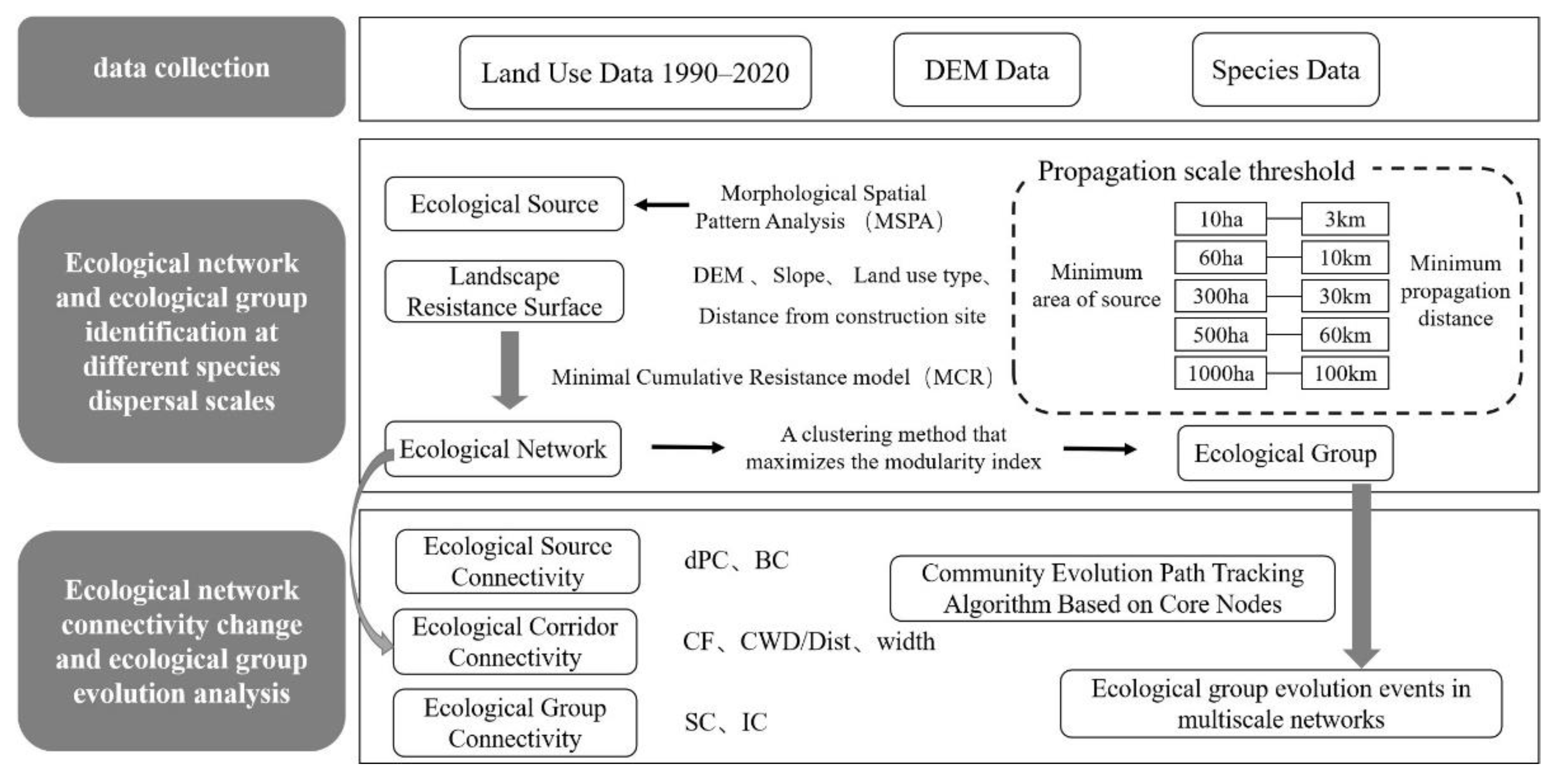
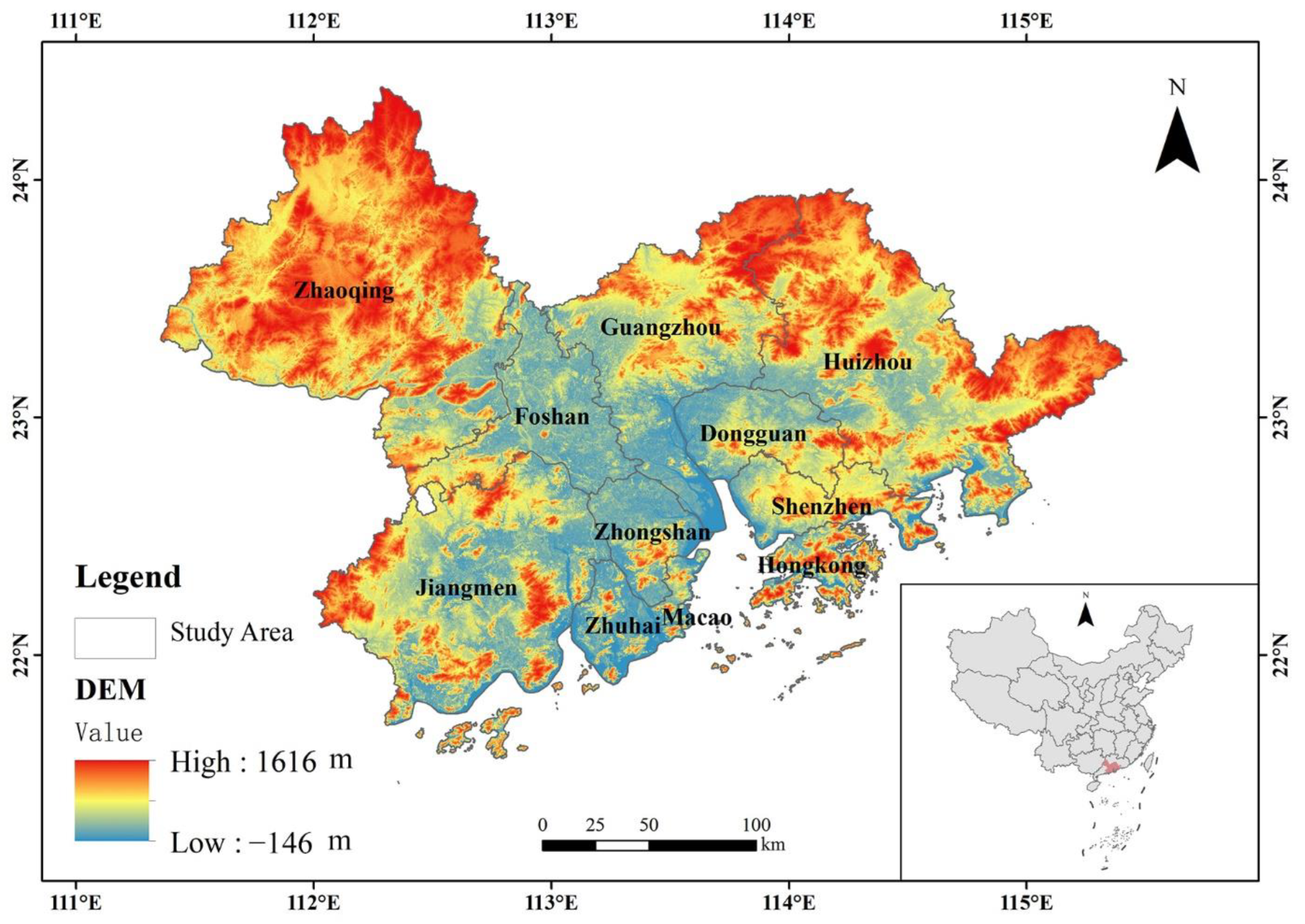
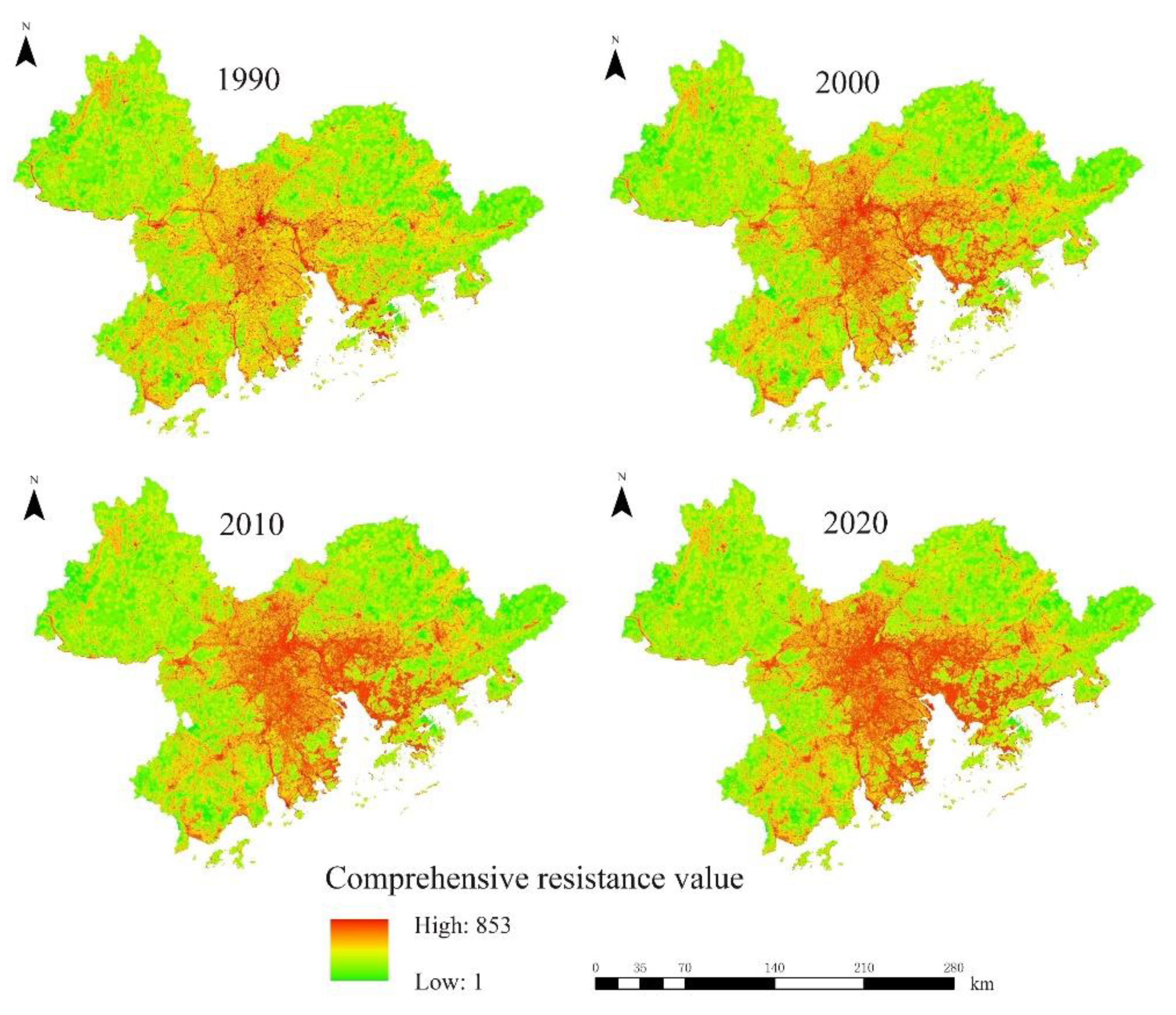
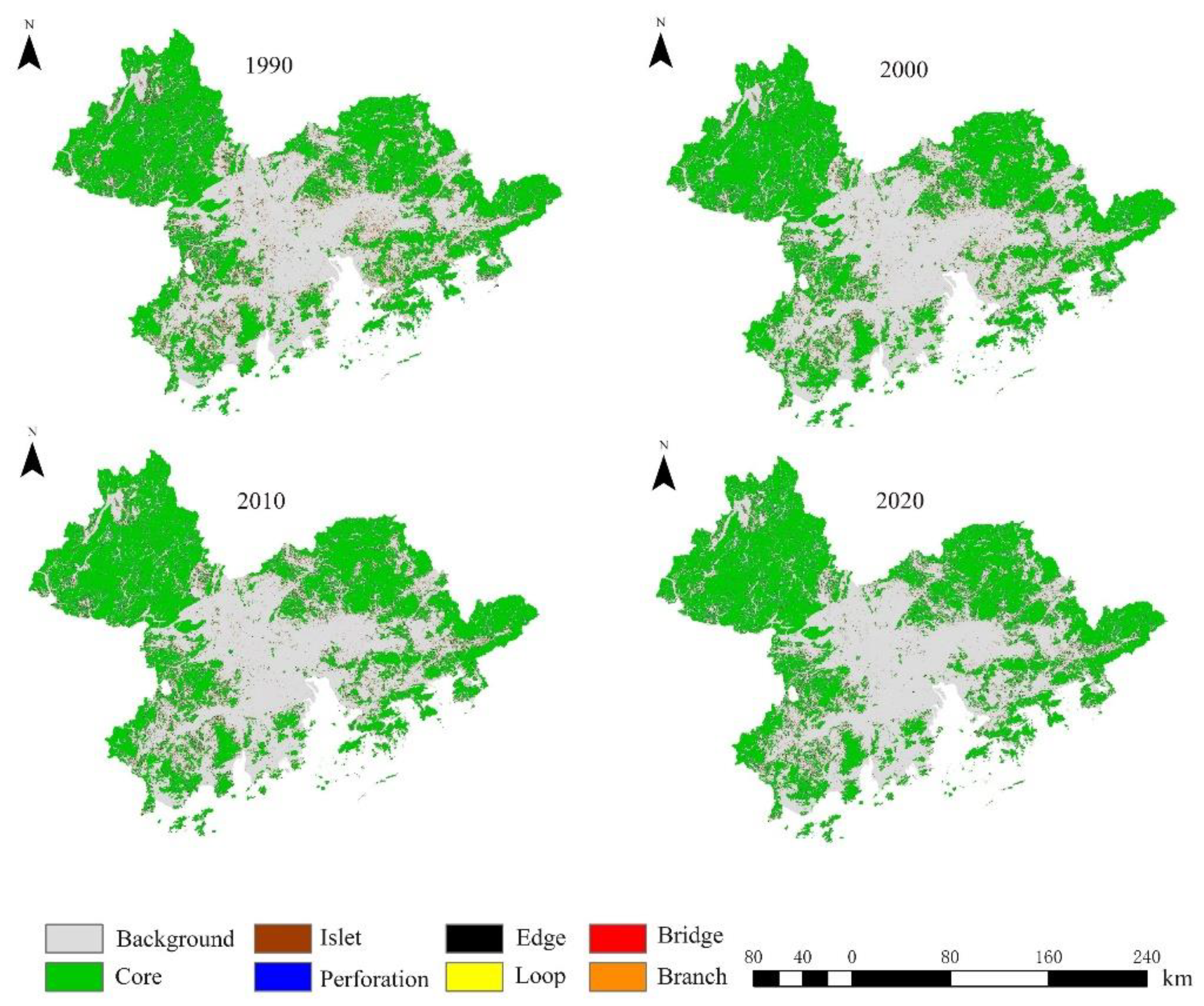
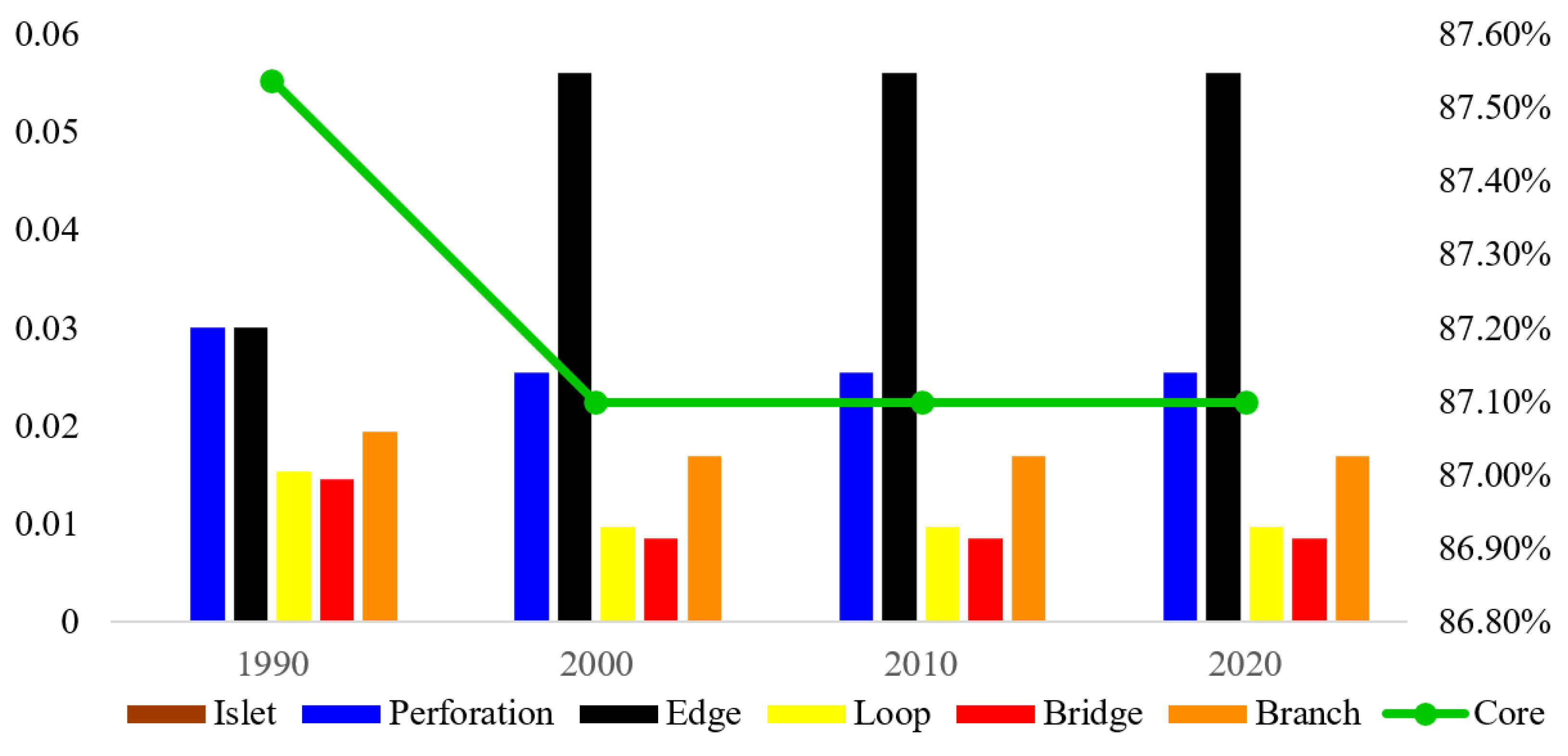
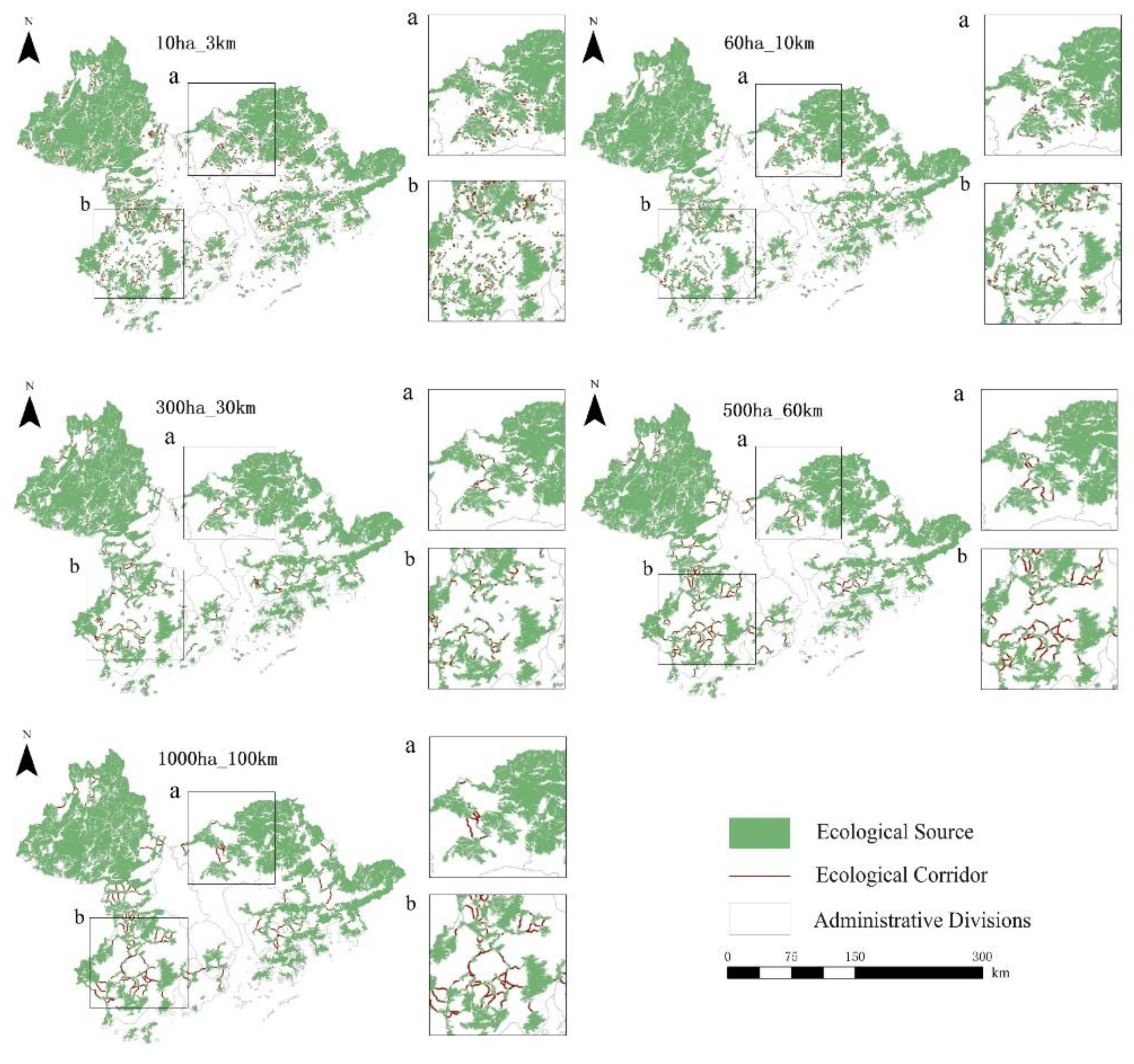
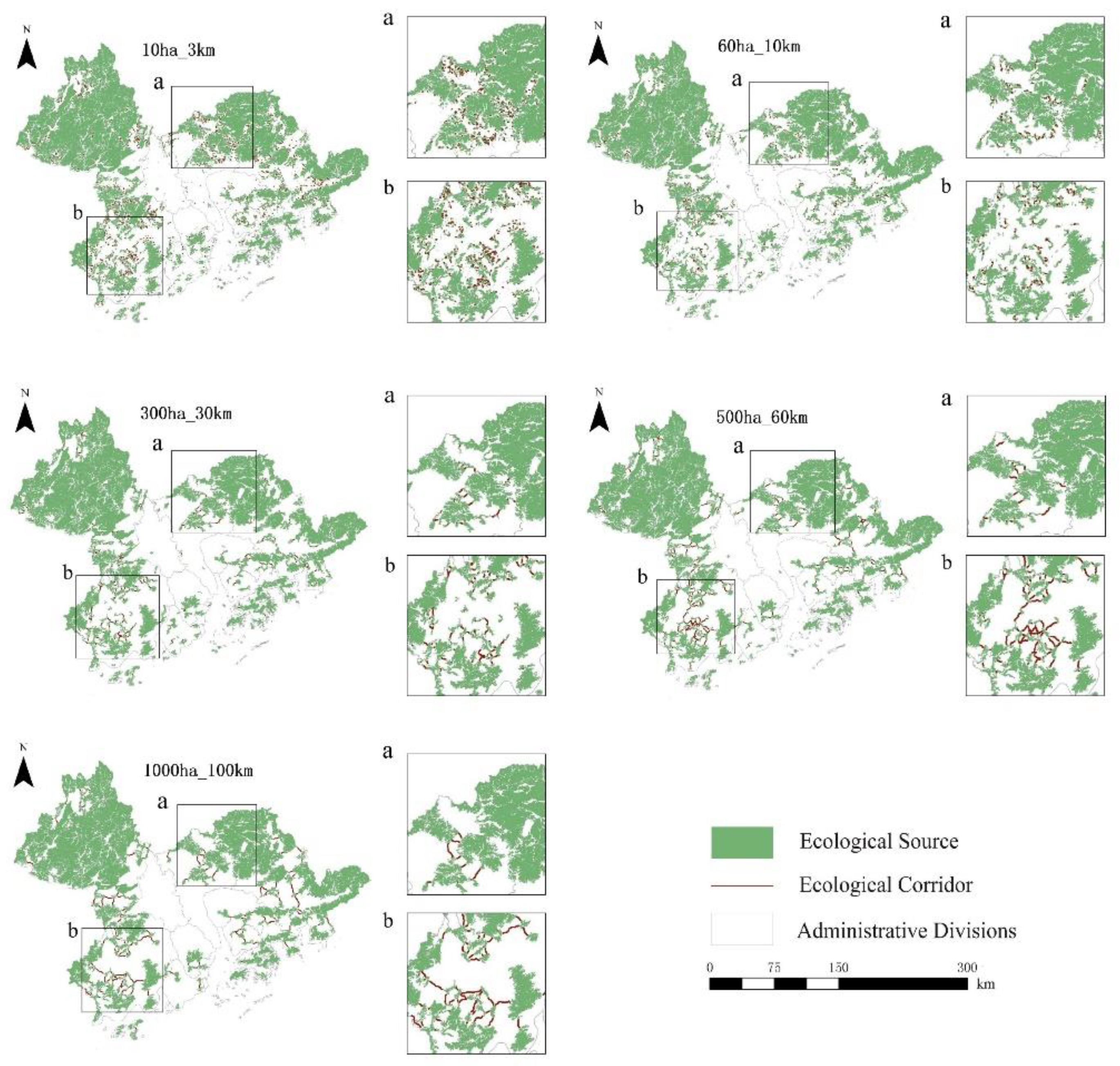
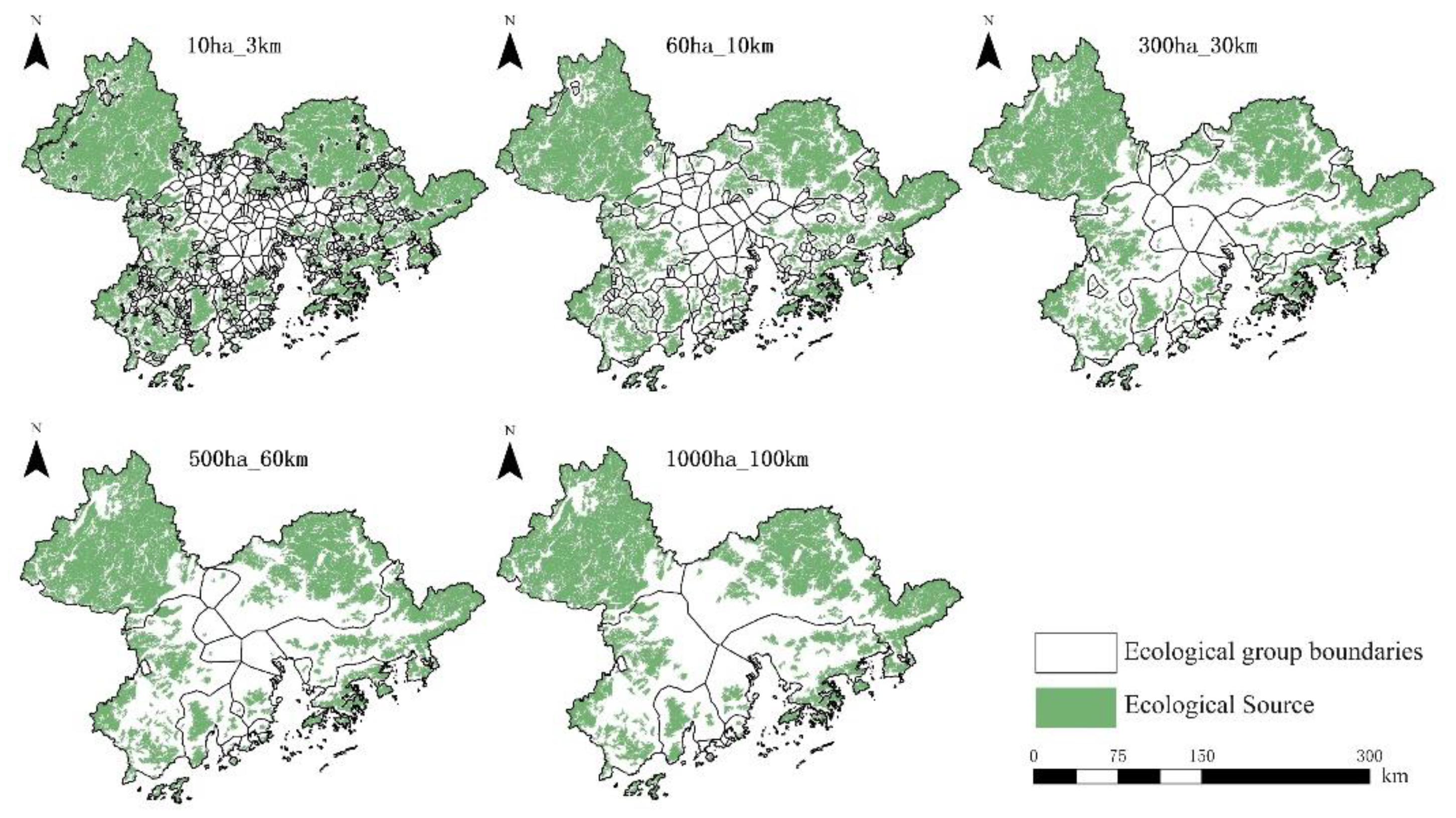
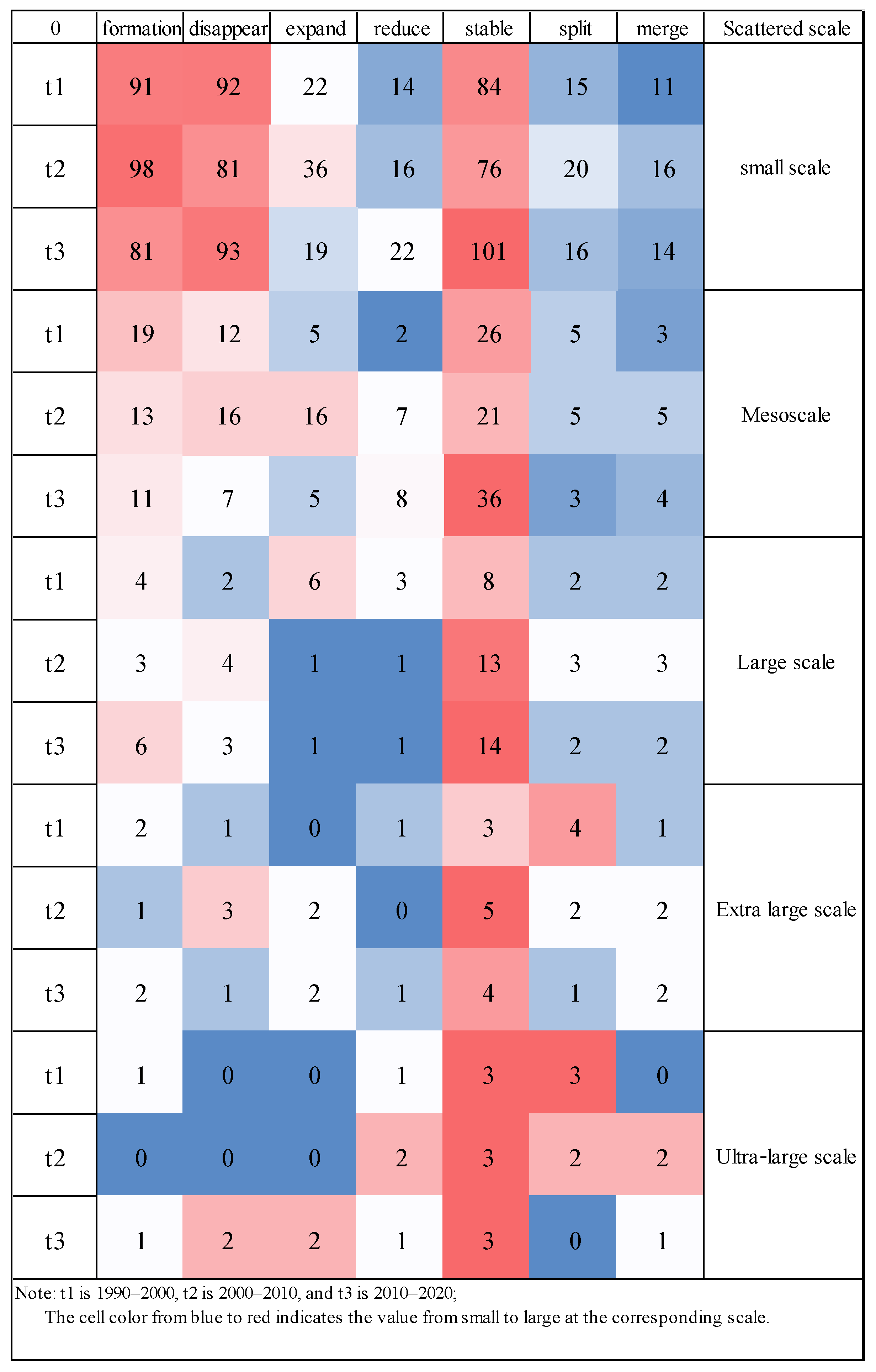
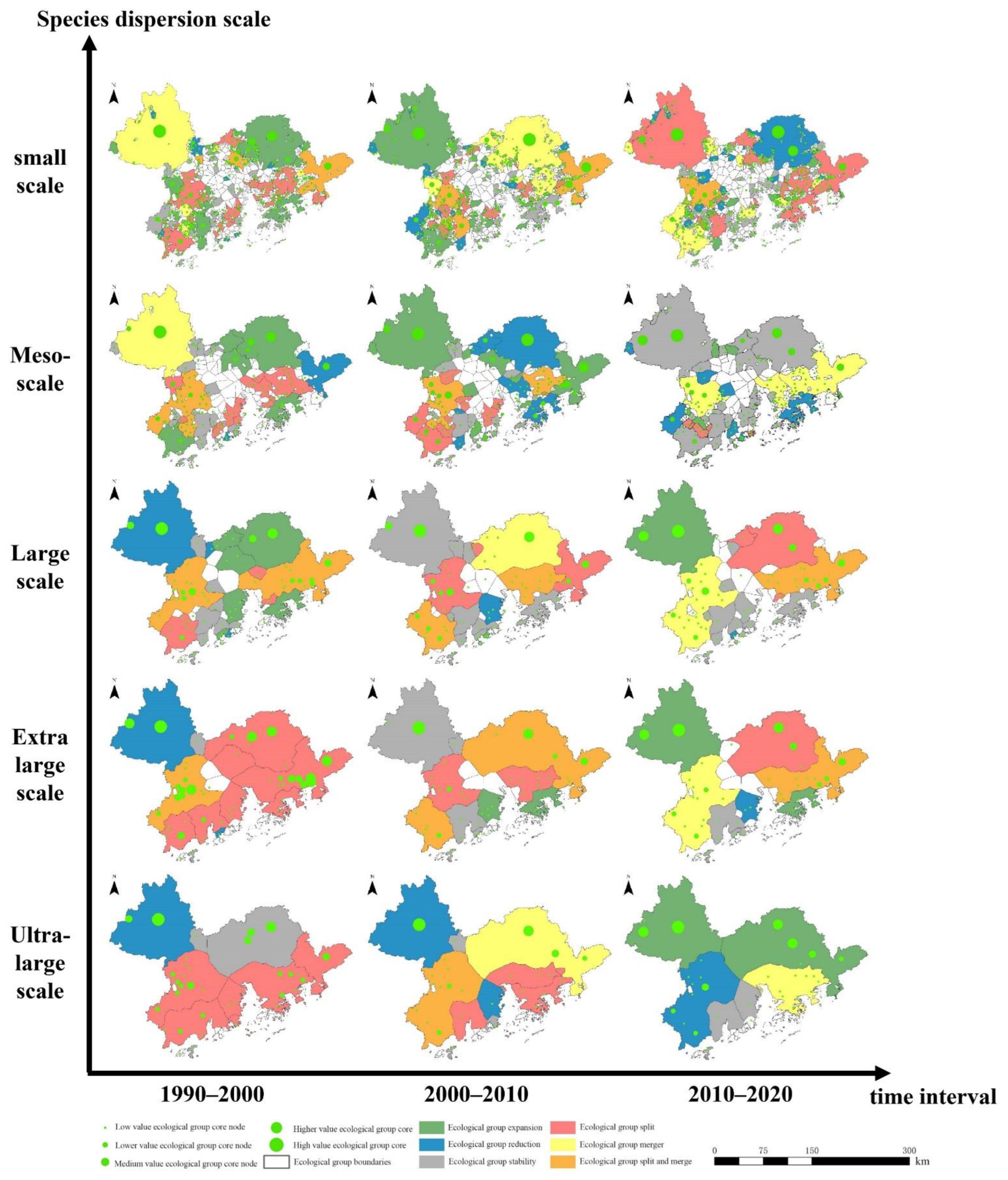
| Data Name | Format and Resolution | Year | Data Source |
|---|---|---|---|
| land use data | 30 m tiff | 1990–2020 | http://doi.org/10.5281/zenodo.4417809, (accessed on 1 May 2022) |
| DEM data | 30 m tiff | 2000–2009 | http://www.gscloud.cn/, (accessed on 1 May 2022) |
| species distribution data | shp | 2008–2021 | https://www.iucnredlist.org/, (accessed on 1 May 2022) |
| Resistance Factor | Category | Weights | Resistance Assignment |
|---|---|---|---|
| land use type | construction land | 0.32 | 1000 |
| water | 900 | ||
| unused land | 600 | ||
| farmland | 500 | ||
| grassland | 100 | ||
| shrub | 1 | ||
| forest | 1 | ||
| Slope (°) | 0–15 | 0.22 | 1 |
| 15–30 | 200 | ||
| 30–45 | 400 | ||
| >45 | 800 | ||
| Elevation (m) | ≤100 | 0.19 | 1 |
| 100–200 | 200 | ||
| 200–400 | 400 | ||
| >400 | 600 | ||
| Distance to construction land (m) | ≤200 | 0.27 | 900 |
| 200–500 | 700 | ||
| 500–1000 | 500 | ||
| 1000–2000 | 300 | ||
| >2000 | 1 |
| Species Maximum Dispersal Distance | Network Index | 1990 | 2000 | 2010 | 2020 |
|---|---|---|---|---|---|
| 3 km | α | −0.084 | −0.118 | −0.112 | −0.096 |
| β | 0.832 | 0.764 | 0.775 | 0.807 | |
| γ | 1,822,293 | 1,754,581 | 2,025,543 | 2,408,752 | |
| 10 km | α | 0 | 0 | −0.006 | 0.013 |
| β | 0.999 | 0.999 | 0.987 | 1.025 | |
| γ | 174,484 | 197,377 | 198,656 | 243,346 | |
| 30 km | α | 0.120 | 0.075 | 0.079 | 0.092 |
| β | 1.234 | 1.145 | 1.152 | 1.179 | |
| γ | 28,667 | 27,412 | 27,590 | 33,042 | |
| 60 km | α | 0.261 | 0.214 | 0.217 | 0.229 |
| β | 1.511 | 1.417 | 1.423 | 1.447 | |
| γ | 17,985 | 18,518 | 16,768 | 18,912 | |
| 100 km | α | 0.358 | 0.266 | 0.270 | 0.290 |
| β | 1.695 | 1.514 | 1.521 | 1.562 | |
| γ | 9546 | 9475 | 7059 | 8661 |
| Species Maximum Dispersal Distance | Connectivity Index | 1990 | 2000 | 2010 | 2020 |
|---|---|---|---|---|---|
| 3 km | mean (median) | 4.75 × 10−4 (2.20 × 10−8) | 4.18 × 10−4 (1.01 × 10−8) | 3.71 × 10−4 (9.54 × 10−9) | 3.84 × 10−4 (1.18 × 10−8) |
| mean (median) | 5.84 × 1014 (0) | 5.51 × 1014 (0) | 1.72 × 1014 (0) | 4.69 × 1014 (0) | |
| 10 km | mean (median) | 1.88 × 10−3 (1.48 × 10−6) | 1.50 × 10−3 (6.81 × 10−7) | 1.40 × 10−3 (1.03 × 10−6) | 1.45 × 10−3 (7.80 × 10−7) |
| mean (median) | 1.15 × 1016 (0) | 6.93 × 1015 (0) | 4.90 × 1015 (0) | 7.91 × 1015 (0) | |
| 30 km | mean (median) | 5.39 × 10−3 (2.96 × 10−5) | 5.38 × 10−3 (9.81 × 10−5) | 4.19 × 10−3 (1.40 × 10−5) | 4.38 × 10−3 (1.78 × 10−5) |
| mean (median) | 1.37 × 1017 (0) | 5.97 × 1016 (0) | 2.98 × 1014 (0) | 8.54 × 1016 (0) | |
| 60 km | mean (median) | 7.83 × 10−3 (1.09 × 10−4) | 6.17 × 10−3 (5.83 × 10−5) | 6.18 × 10−3 (6.14 × 10−5) | 6.66 × 10−3 (5.53 × 10−5) |
| mean (median) | 4.19 × 1017 (0) | 2.49 × 1017 (2.90 × 1014) | 6.80 × 1016 (0) | 2.69 × 1017 (0) | |
| 100 km | mean (median) | 1.19 × 10−2 (3.86 × 10−4) | 9.76 × 10−3 (1.96 × 10−4) | 1.02 × 10−2 (2.17 × 10−4) | 1.05 × 10−2 (2.05 × 10−4) |
| mean (median) | 5.79 × 1017 (5.65 × 1015) | 4.96 × 1017 (3.79 × 1015) | 4.28 × 1017 (5.78 × 1015) | 3.85 × 1017 (2.06 × 1015) |
| Species Maximum Dispersal Distance | Index | 1990 | 2000 | 2010 | 2020 |
|---|---|---|---|---|---|
| 3 km | quantity | 2133 | 2006 | 2171 | 2416 |
| CWD_LCPL | 5.64 | 6.39 | 6.56 | 6.75 | |
| Average width (m) | 3535.61 | 2444.86 | 2510.35 | 2210.49 | |
| CF mean | 715.74 | 682.02 | 401.10 | 462.39 | |
| 10 km | quantity | 724 | 770 | 768 | 866 |
| CWD_LCPL | 6.32 | 7.08 | 7.39 | 7.65 | |
| Average width (m) | 24,703.07 | 19,153.41 | 18,861.34 | 18,821.88 | |
| CF mean | 833.26 | 592.79 | 820.49 | 814.51 | |
| 30 km | quantity | 327 | 308 | 310 | 343 |
| CWD_LCPL | 6.78 | 7.62 | 8.02 | 8.10 | |
| Average width (m) | 156,048.98 | 139,446.57 | 117,817.05 | 128,884.65 | |
| CF mean | 552.33 | 295.89 | 560.69 | 536.61 | |
| 60 km | quantity | 287 | 282 | 269 | 288 |
| CWD_LCPL | 6.72 | 7.57 | 8.06 | 8.14 | |
| Average width (m) | 506,442.07 | 427,184.24 | 347,738.74 | 390,902.57 | |
| CF mean | 540.98 | 589.73 | 309.09 | 424.63 | |
| 100 km | quantity | 222 | 209 | 181 | 203 |
| CWD_LCPL | 6.54 | 7.42 | 7.97 | 8.04 | |
| Average width (m) | 1,179,694.60 | 1,124,838.41 | 790,221.52 | 946,413.21 | |
| CF mean | 303.01 | 273.68 | 220.67 | 234.96 |
| Years | Species Dispersion Scale | Number of Ecological Groups | The Number of Core Nodes of the Ecological Group |
|---|---|---|---|
| 1990 | Small scale (3 km) | 806 | 424 |
| Mesoscale (10 km) | 175 | 121 | |
| Large scale (30 km) | 54 | 55 | |
| Extra-large scale (60 km) | 23 | 44 | |
| Ultra-large scale (100 km) | 12 | 35 | |
| 2000 | Small scale (3 km) | 930 | 436 |
| Mesoscale (10 km) | 192 | 149 | |
| Large scale (30 km) | 54 | 69 | |
| Extra-large scale (60 km) | 27 | 49 | |
| Ultra-large scale (100 km) | 14 | 33 | |
| 2010 | Small scale (3 km) | 994 | 442 |
| Mesoscale (10 km) | 195 | 142 | |
| Large scale (30 km) | 53 | 59 | |
| Extra-large scale (60 km) | 28 | 39 | |
| Ultra-large scale (100 km) | 14 | 26 | |
| 2020 | Small scale (3 km) | 1019 | 446 |
| Mesoscale (10 km) | 207 | 148 | |
| Large scale (30 km) | 60 | 66 | |
| Extra-large scale (60 km) | 28 | 41 | |
| Ultra-large scale (100 km) | 12 | 30 |
Publisher’s Note: MDPI stays neutral with regard to jurisdictional claims in published maps and institutional affiliations. |
© 2022 by the authors. Licensee MDPI, Basel, Switzerland. This article is an open access article distributed under the terms and conditions of the Creative Commons Attribution (CC BY) license (https://creativecommons.org/licenses/by/4.0/).
Share and Cite
Wu, J.; Zhang, S.; Wen, H.; Fan, X. Research on Multi-Scale Ecological Network Connectivity—Taking the Guangdong–Hong Kong–Macao Greater Bay Area as a Case Study. Int. J. Environ. Res. Public Health 2022, 19, 15268. https://doi.org/10.3390/ijerph192215268
Wu J, Zhang S, Wen H, Fan X. Research on Multi-Scale Ecological Network Connectivity—Taking the Guangdong–Hong Kong–Macao Greater Bay Area as a Case Study. International Journal of Environmental Research and Public Health. 2022; 19(22):15268. https://doi.org/10.3390/ijerph192215268
Chicago/Turabian StyleWu, Jiansheng, Shengyong Zhang, Haihao Wen, and Xuening Fan. 2022. "Research on Multi-Scale Ecological Network Connectivity—Taking the Guangdong–Hong Kong–Macao Greater Bay Area as a Case Study" International Journal of Environmental Research and Public Health 19, no. 22: 15268. https://doi.org/10.3390/ijerph192215268
APA StyleWu, J., Zhang, S., Wen, H., & Fan, X. (2022). Research on Multi-Scale Ecological Network Connectivity—Taking the Guangdong–Hong Kong–Macao Greater Bay Area as a Case Study. International Journal of Environmental Research and Public Health, 19(22), 15268. https://doi.org/10.3390/ijerph192215268






